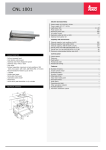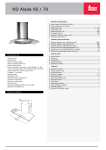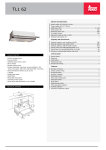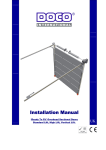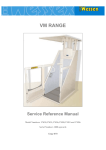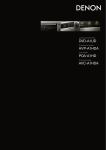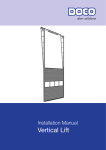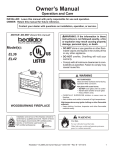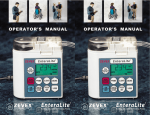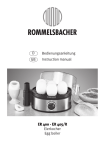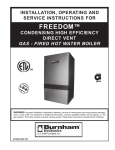Download Ashworth PRO6068PS10LTPIWSTNK Instructions / Assembly
Transcript
Installation Guidelines Patio Doors Inswing / Outswing / Entry / Sliding Patio Door 900 South 19th Street West Des Moines, IA 50265 800.935.2000 www.ashworthdoors.com #5011892 4/2012 Installation Guidelines for Ashworth Patio Doors Installer • Read instructions completely before attempting installation. Failure to follow these guidelines will forfeit the Ashworth warranty coverage, written or implied. • Always provide a copy of these instructions to the homeowner. • These instructions are consistent with ASTM 2112 “Standard Practice for Installation of Exterior Windows, Doors and Skylights” into common wall constructions. Contact your architect or construction professional for installation into other building designs or construction methods. • Regional codes and environmental conditions may require installation that is different from these guidelines. It is your responsibility to ensure that local codes and ordinances are followed. Warning! Work Safe! Always wear proper eye and hearing protection when installing or adjusting Ashworth products. Use Power Tools Properly! To avoid personal injury, always follow manufacturers’ instructions for safe operation of power tools. Ladder Safety! Working at elevated levels can be hazardous. Always use ladders and scaffolding properly. Consult manufacturers’ guidelines for safe use of these types of equipment. Safety Glazing! Some Ashworth products may not contain safety glazing unless specifically ordered that way. Use caution – injury could result if glass is broken and fragmented. Building codes require safety glazing for windows installed in certain areas. Consult your local building code official for guidelines. Important • A shworth reserves the right to change the information contained in these guidelines without notice. • Maintain a minimum of 1/4" between the door frame and any trim, siding or masonry. • Use of Ashworth products in barrier EIFS systems (synthetic stucco) is not recommended. To do so will forfeit all warranties (written or implied), and Ashworth will not be held responsible for any claims or damages resulting from water infiltration. • Steel fasteners will corrode when used with ACQ Pressure Treated Lumber. Use corrosion resistant fasteners (such as stainless steel) when installing windows in or around these types of materials. • Door nailing flanges and drip caps (integral or applied) do not take the place of window flashing. All windows and doors must be properly flashed and sealed around the perimeter. Handling and Storage • Always carry door units upright. Do not carry flat! Doing so could result in damage to the unit. • Do not store units outside. Note: These installation instructions contain two methods of installation: Nail fin and no nail fin installation. Tools Needed Materials Needed • Safety Glasses • B acker Rod – 1/4"-1/2" diameter closed cell foam • Utility Knife • Hammer (or Nail Gun) • Insulation – Minimally expanding low pressure polyurethane window and door foam • Caulk Gun • S hims – Made of cedar or synthetic material • Level • 2-1/2" Drywall Screws – (No Nail Fin Installation) • Ladder / Scaffolding • R oofing Nails (Nail Fin Installation) – 2" Galvanized (16D) • Square • S ilicone Sealant – 100% Silicone • Tape Measure • Stapler • F lashing (Nail Fin Installation) – Self-adhesive flexible flashing that complies with ASTM-D779 • Screwdriver Step 1: Inspect Unit Before Installation: A) Remove all shipping packaging material (blocks, pads, protectors, stretch wrap). B) Inspect unit for any damage or defects. C) Verify the door unit is the correct size and configuration. D) Contact the nearest Ashworth distributor if there is a problem. Step 2: Prepare Rough Opening Note: Disregard steps B, F, G, H and I if No Nail Fin Installation is utilized. A) Measure and verify the size of the rough opening. The rough opening should be 3/4" larger in width and 1/2" larger in height than the frame size. B) For doors with clad exterior casings, additional nailer studs may be required around the perimeter of the rough opening. C) Verify the rough opening is flat, plumb, level and square. (Fig. 1) D) Take diagonal measurements to check for square. (Fig. 1) E) Make sure the bottom sill area of the rough opening is flat and level. Correct rough opening if sloped towards the interior, out of level or humped. (Fig. 1) F) Cut the weather-resistant barrier (WRB) in a “Modified I” pattern. (Fig. 2) G) Fold back the WRB on the sides toward the interior and staple into place. (Fig. 3) H) From the exterior, cut the top of the WRB as shown to form a flap. (Fig. 4) I) Temporarily tape this top flap up. (Fig. 4) int eXT fig. 1 int eXT fig. 3 fig. 2 fig. 4 Step 3: Flashing the Sill A) IMPORTANT! a. Use flashing that is 6" minimum in width. b. Flashing must meet ASTM-D779 performance requirements. B) Measure the width of the rough opening. Cut a length of flashing that is 12" wider than the rough opening. This will allow you to run the flashing 6" up each side. C) Cut 1-1/2" slits at each end of the flashing as shown below. (Fig. 5) 6" minimum 1-1/2" 6" 1/2" fig. 5 D) Apply sill flashing to the rough opening as shown below. (Fig. 6) E) Flashing tape must cover the entire sill. If needed, apply an additional flashing piece over the first one (start from the exterior and work towards the interior). Maintain a minimum 1" overlap. (Fig. 7) int eXT int eXT fig. 6 fig. 7 Step 4a: Nail Fin Door Installation (Go to Step 4b for No Nail Fin Installation) A) Removeallpackagingmaterial(blocks,pads,protectors,stretchwrap,nailfin). B) Inspectandverifythefollowing: a. Thedoorunitisthecorrectsizeandconfiguration. b. Theunitisfreefromanydamageordefects. C) ContactyournearestAshworthdistributorifthereareanyproblemswithstepBabove. D) Installthesuppliednailfintobothsidesandtopofthedoorasshownbelow.Thelocationofthenail findependsonthejambdepthoftheroughopening.Ensurethecorrectlocationischosenpriorto applyingthenailfin.(Fig.8) E) Applythesuppliednailfincornergaskets. F) Applysealanttotheoutsidefaceofthenailfin.Toolinsealanttoensurenovoids.(Fig.9) NAIL FIN DRIP CAP (MULLED UNITS) FIG. 8 SILICONE DESIRED JAMB DEPTH FIG. 9 G) Installuppernailfincornergaskets.(Fig.10) a. Removeprotectivepaperfrombackofnailfincornergasket. b. Placefoamnailingfingasketovercornerwithinsidecornerofthegaskettightagainstoutside framecorner. c. Repeatapplicationatallcornerswherethenailfinsmeet. H) Applysealanttotheinteriorsideoftheheadandsidenailfin.Applya1/4"continuousbeadofsiliconein linewithandcompletelycoveringthenailfinholes.(Fig.11) FIG. 10 FIG. 11 I) Applysealanttosillroughopening: a. Applythree1/4"continuousbeadsofsiliconeacrosstheentirewidthoftheroughopening.Note thelocationsaredifferentforeachdoortype.Fig.13showsthesiliconelocationfora4-9/16"and 6-9/16"inswingdoor.Thebeadlocationwillbedifferentforotherjambsizes.(Fig.12&13) 4 14" (4 169 " FRAME) 6 14" (6 169 " FRAME) SEALANT FIG. 12: OUTSWING PATIO SILL 1" (4 169 " FRAME) 3" (6 169 " FRAME) FIG. 13: 4-9/16" & 6-9/16" INSWING PATIO DOOR SILL b. A pplya1/4"continuousbeadofsilicone1/2"fromeach sideoftheroughopening. Thebeadwillruntheentire depthofthejambstartingatthefaceofthewall.(Fig.14) J) S etthedoorintotheroughopening.Centertheunitin theopening,makingsurethereareequalgapsonboth sidesofthedoor. K) Temporarilytackthedoorinplaceusing2"galvanized roofingnailsthroughthepre-punchedholesatbothtop cornersofthenailingflange.Donotdrivethenailsinfully. eXT L) S tartwithashimateachcornernomorethan1"from thejambcorner. Addadditionalshimsspacedevenly fromthecenteroftheunitmakesureshimsarespaced nomorethan16"apart.Notetouseflatshimsorpairsof triangleshimstoensurethejambdoesnottwist.(Fig.15) M) A dditionalshimsarerequiredateachlockpoint,headshootboltand hingelocationforalloperatingdoors.(Fig.15) N) N ailallfourcornersinplacethroughthepre-punchedholesinthe nailflange. O)Finishnailingthedoortotheroughopening.Useanailateachnailfin hole,8"-10"apart. Step 4b: No Nail Fin Door Installation FIG. 14 SWINGING PATIODOOR FIG. 15 A) R emoveallpackagingmaterial(blocks,pads,protectors,stretchwrap). B) Inspectandverifythefollowing: a. Thedoorunitisthecorrectsizeandconfiguration. b. Theunitisfreefromanydamageordefects. C) C ontactyournearestAshworthdistributorifthereareanyproblemswithstepBabove. D) Measureinfromtheexteriorsideoftheunit2-5/8"andmarkthisatfourequallyspacedpointsalong eachsidejambandthreeequallyspacedpointsalongtheheadjamb.Thendrilla1/8"pilotholethrough theentireunitateachofthe11markedplaces.(Fig.16) E) Afterthepilotholehasbeencreated,drilla25/64"holethroughthealuminumcladdingonly.(Fig.16) F) Testfittheunitintheroughopeningandsettheunittotheappropriatejambdepth.Oncethecorrect jambdepthhasbeendetermined,drawalinealongtheinsideofthesillonthesubfloor.(Fig.17) 1/8" DIA. 2-5/8" INTERIOR LINE LOCATION 25/64" DIA. FIG. 16 FIG. 17 G) Removetheunitfromtheopening. H) Applysealanttosillroughopening: a. Applythree1/4"continuousbeadsofsiliconeacrosstheentirewidthoftheroughopening.(Fig.18) showsthesiliconelocationfora4-9/16"and6-9/16"inswingdoor.Thebeadlocationwillbedifferent forotherjambsizes.(Fig.18) b. Applya1/4"continuousbeadofsilicone1/2"fromeachsideoftheroughopening.Thebeadwill runtheentiredepthofthejambstartingatthefaceofthewall.(Fig.19) SEALANT 4 12" (4 169 " FRAME) 6 12" (6 169 " FRAME) 3 5/8" 1/2" INT eXT FIG. 18: 4-9/16" & 6-9/16" INSWING PATIO DOOR SILL FIG. 19 I) S etthedoorintotheroughopening.Centertheunitintheopening,making surethereareequalgapsonbothsidesofthedoor. J) Temporarilyholdthedoorinplaceusing2-1/2"drywallscrewsthroughthe pre-drilledholesatbothtopcornersofthedoorframe.Donotdrivethe screwsinfully. K) Startwithashimateachcornernomorethan1"fromthejambcorner. Addadditionalshimsateachpre-drilledframehole.Notetouseflatshims orpairsoftriangleshimstoensurethejambdoesnottwist.(Fig.20) L) Additionalshimsarerequiredateachlockpoint,headshootboltandhinge locationforalloperatingdoors.(Fig.20) Bi-hingeshootboltshim SWINGING PATIODOOR FIG. 20 M) Screwallfourcornersinplacethroughthepre-drilledholesintheframe. N) Finishscrewingthedoortotheroughopening.Applyascrewthroughall11pre-dilledframeholes. Step 5: Secure Hinge and Verify Operation A) A pplythesupplied#12x2-1/4"screwsthrougheachhingesecuringthe hingesandframetotheroughopening.Additionalshimsarerequired behindeachhinge.(Fig.21) B) Verifytheoperationofthedooriscorrect.Bydoingsoyouwillverify thedoorswingswithoutbindingonanothermemberofthedoorandby remainingmotionlessthroughouttheoperationwhenleftinstaticposition. C) Iftheoperationofthedoorisnotcorrect,firstverifytheroughopeningis plumb,levelandsquare.Second,verifythedoorisshimmedandfastened properlyasstatedintheseinstructions.Third,verifythehingesareadjusted totheoptimalposition. FIG. 21 Step 6: Completing the Sill Note: Disregard Step A if No Nail Fin Installation is utilized. A) I MPORTANT!Belowthenailfinatbothbottomcorners,applyagenerousamountofsiliconetoseal thevoidbetweentheroughopeningandthesill.Ifthegapistoolarge,insertbackermaterialinthevoid priortosealing.(Fig.22) B) A ttachasillsupportblockbeneaththesill.Applyabeadofsealantatthenoseofthesillandsupport block.(Fig.23) C) Applysiliconetosealeachendofthesillcavitythatprotrudesfromtheroughopening.(Fig.24&25) SEALANT LOCATION SILL SUPPORT (BY OTHERS) SEALANT FIG. 22 FIG. 23: STANDARD DOOR SILL SEALANT SEALANT FIG. 24: OUTSWING SILL FIG. 25: INSWING SILL Step 7: Complete Flashing (Nail Fin Installation Only) A) Cutandapplysideflashing.Sideflashingshouldrunfromthebottomofthesillflashingto4"abovethe roughopening.(Fig.26) B) Ifnon-adhesiveflashingisused,makesureallstapleholesaresealedwithsilicone. C) Cutandapplyheadflashing.Theheadflashingshouldrunslightlypasttheedgeofthesideflashingas shown.(Fig.27) D) FlipdownthetopflapoftheWRB.(Fig.28) E) TapethecutseamsoftheWRB.(Fig.29) FIG. 26 FIG. 27 FIG. 28 FIG. 29 Step 8: Seal the exterior A) Aftersidingorwallexterioriscomplete,applybackerrodandsealantbetweenthedoorframeand sidingmaterialonbothsides.Seefigures30and31fornailfininstallationandfigures32and33forno nailfininstallation. B) W ARNING: Maintainaminimumof1/4"betweenthedoorframeandanytrim,sidingormasonry. Failuretodosowillforfeitallwarranties(writtenorimplied).Ashworthwillnotbeheldresponsiblefor anyclaimsordamagesresultinginfailuretofollowtheseinstructions. INSULATION SHIM & INSULATION NO SEALANT 1/4" MIN. SEALANT & BACKER ROD 1/4" MIN. FIG. 30: SIDe JAMB – NAIL FIN INSTALLATION FIG. 31: HeAD JAMB – NAIL FIN INSTALLATION SHIM & INSULATION SHIM & INSULATION 1/4" MIN. SEALANT & BACKER ROD 1/4" MIN. FIG. 32: SIDe JAMB – NO NAIL FIN INSTALLATION FIG. 33: HeAD JAMB – NO NAIL FIN INSTALLATION Step 9: Completing the Installation A) R emovealllabelsorshippingmaterials. B) Hingeadjustmentmayberequiredtocompletetheinstallation.(Fig.34) Top hinge adjusts a. Whenadjustingthehinge,useahandscrewdriver. horizontally b. Usethetopandbottomhingetoadjustthedoorpanelhorizontally. c. Usethecenterhingetoadjustthedoorpanelvertically. C) Insulatebetweenthedoorframeandtheroughopeningusing minimallyexpandingwindowanddoorsprayfoaminsulation.Use cautiontonotoverfillthegapcausingthejambstobow.Itisnot Center hinge recommendedtoapplytrimtotheunituntilthefoamhascured adjusts vertically toallowtheexcesstoescape.(Fig.30,31,32&33) D) Operatedoorunittoensureproperoperation.Thepanelwill notoperatecorrectlyifthedoorisoutofsquare,over-shimmed orover-insulated. Bottom hinge adjusts E) ProperlyfinishallInteriorwoodcomponentswithin30days horizontally ofinstallation. FIG. 34 F) IMPORTANT:Donotstainorpaintanyhardwareorvinylcomponents. G) Applythehandlesetasappropriateperthemanufacturer’srecommendations.Completefinal adjustmentsasnecessary. H) Swingingdoorsaretoremainclosedandlockedduringconstructiontopreventsiteconditionsfrom damagingand/orwarpingpanelsandframes.Allow10-12weeksfromprojectcompletionforbuilding temperatureandhumiditylevelstostabilizeanddoorpanelstoacclimate. if you should have any questions from installation to adjustments of the Ashworth by Woodgrain millwork products please contact Ashworth directly at 1.800.935.2000.Visit www.ashworthdoors.com to find additional information on your Ashworth Door including maintenance, finishing and warranty information to help assist you in preserving the integrity and reliability of your Ashworth products.











